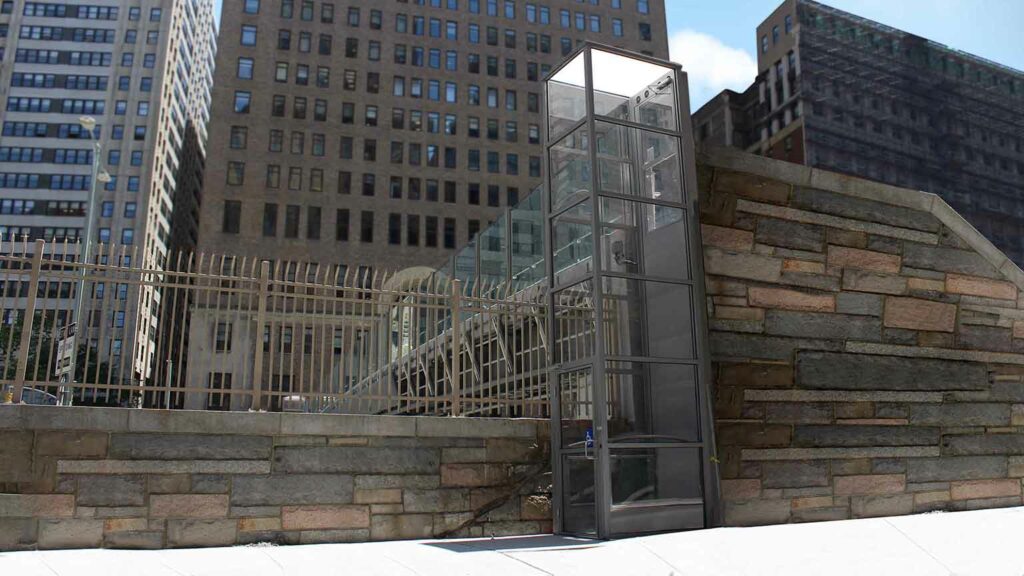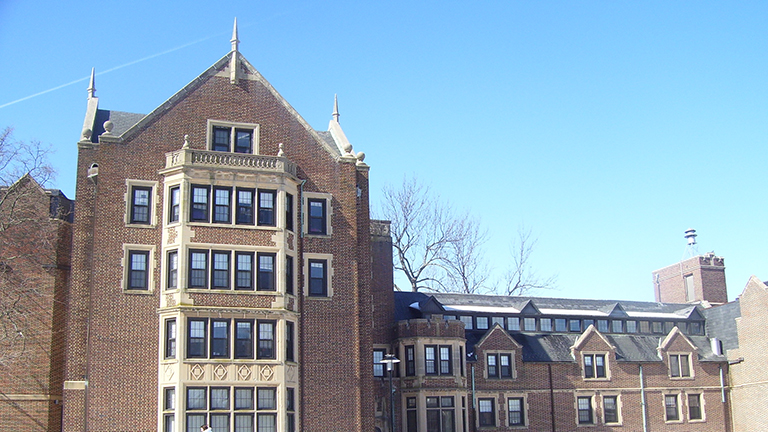Choosing a wheelchair lift often seems like a stressful and complicated process. However, in order to ease the tension, provided below is the What, Who, When, Where, Why and How of Wheelchair Lift Shopping. For more information, see our platform lift comparison chart.
What is a Wheelchair Lift?
Also known as a platform lift, wheelchair lifts assist disabled persons in overcoming architectural barriers. Barriers are any obstacle hindering a persons negotiation of any area, such as stairs, high counters, or steep ramps. A wheelchair lift assists by raising and lowering its rider up over, or down from, barriers.
Things to Consider: Wheelchair lift manufacturers offer a variety of package options. These options differ with respect to each installation site and code requirements across different jurisdictions. Some options include: fixed and portable models, outdoor packages, 90° or side door exits, and keyed operation.
Who Needs a Wheelchair Lift?
In general, disabled or convalescent individuals who need help getting around their home, or facility managers who are working to make their location more accessible, may need a wheelchair lift.
Things to Consider: Wheelchair lifts are not only for persons using wheelchairs. In addition, anyone with difficulty negotiating obstacles either around their home or in public may benefit from a lift. As an example, religious buildings, schools, parks, and convention centers are often public facilities that need platform lifts in order to adequately accommodate the communities they serve.
When is a Wheelchair Lift Required by the ADA?
Certain events or requirements will spark the necessity of a wheelchair lift. For example, new constructions must uphold the Americans with Disabilities Act (ADA) standards as well as the Americans with Disabilities Accessibility Guidelines (ADAAG). In addition, 20% of the total cost of any renovation goes toward accessible modifications. In both of these cases, a platform lift would conform to code standards.
Things to Consider: If you are purchasing a lift for a public facility or business, you might ask yourself: what is your patron demographic and how accessible is your location? In many instances, public spaces will often use a wheelchair lift to assist patrons in negotiating the facilities. A lift gives patrons easy access to recreation areas, entranceways, or events, which they may otherwise be unable to attend. Moreover, ask yourself: can people enter and exit freely with full access to all locations and services within the building? If you are thinking of buying a lift for your home, what are you having difficulty accessing around your property? Furthermore, space restrictions or a desire for building preservation may facilitate the need for a platform lift.
Where is a Lift used?
The most commonly used type of wheelchair lifts—vertical platform lifts (VPLs)—are found in both residential and commercial settings. When stairs cannot be used, a VPL installed in a private home or public facility provides access to porches, entryways, and many other areas. VPLs are also commonly used in public and commercial settings, such as schools, religious institutions, public parks, and convention centers.
Things to Consider: When deciding where to place a lift, carefully measure the area where you plan to install it. A common wheelchair lift “footprint” is typically within 52″x 66″ and may have a mast height or hoistway height requirement as well. In addition, some lifts will require an entry ramp, which will add to the overall footprint size. However, most lifts have the option of being installed into a “pit” to do away with an entry ramp. This pit is commonly a 3″ deep hole with an area the size of the lifts footprint dug out of the floor or ground. In turn, the pit allows the lift to sit flush with the ground, doing away with the need for an entry ramp. It should be noted, some lift models that do not require either a ramp or installation pit while still providing ground level access.
Why buy a Wheelchair Lift?
There are many reasons to purchase a wheelchair lift as a means for providing access. For example, if a given location has space restrictions for installation or storage, a wheelchair lift may be able to provide the necessary access without taking up much space. On the other hand, some public venues, such as theaters or hotels, may be more interested in the aesthetic of using a low profile lift as opposed to using a larger ramp.
Things to Consider: Like platform lifts, wheelchair ramps must conform to stringent code requirements regarding the 1:12 rise-over-run and 36″ pathway width. Other issues may apply in regard to handrails and edge protection based on local code adoptions and site requirements. However, these requirements often cannot be feasibly accommodated within a site’s space restrictions. Thus, a wheelchair lift serves as a more viable option.
How to Purchase a Lift?
Due to the many different options available for each type of lift, as well as the code requirements that must be met for each installation, consultation with a product specialist (either a lift manufacturer or an authorized dealer) is strongly recommended. Such consultation will ensure that you get the right lift for your needs. For options about how to fund purchasing a wheelchair lift read, “Funding your Wheelchair Lift.”
Things to Consider:
- If you are purchasing for a facility or institution, you may want to look at a manufacturer’s website and browse through their customer list and testimonials page to see if they have clients similar to you. This way, you’ll gain a better idea of what has worked for others and who your competition is using.
- The platform lift industry offers both portable as well as permanently-installed models. Choosing which type you need is based on your situation, as well as code requirements enforced in your area.
- How do you plan on using the lift? If you operate a theater house and need a lift for actors, events, and patrons, you will probably want a lift that is low-profile and quiet. For college graduation ceremonies, portable models that move out of place when not needed might make more sense.
- For architect and engineer, see our code page for a breakdown of accessibility and safety codes. Also available are links to further resources for specifying different wheelchair lifts.
Questions to ask a product specialist:
- How easy is it to install and use the lift?
- If you are purchasing a portable model, find out how easy it is to break down, transport, and setup.
- What is your warranty and what does it include?
- Warranties are important for any purchase; they are reflections of a company’s faith in their product, so a longer warranty will likely indicate a higher-quality product.
- What makes your lift better than your competitors’?
- It sounds like a cliché question, but it’s one worth asking. Each lift is different from the next, so it’s important to verify which lift will meet your needs.
- How loud is it?
- Each lift makes noise, but some are louder than others. You will need to decide what noise level is appropriate for your venue.



